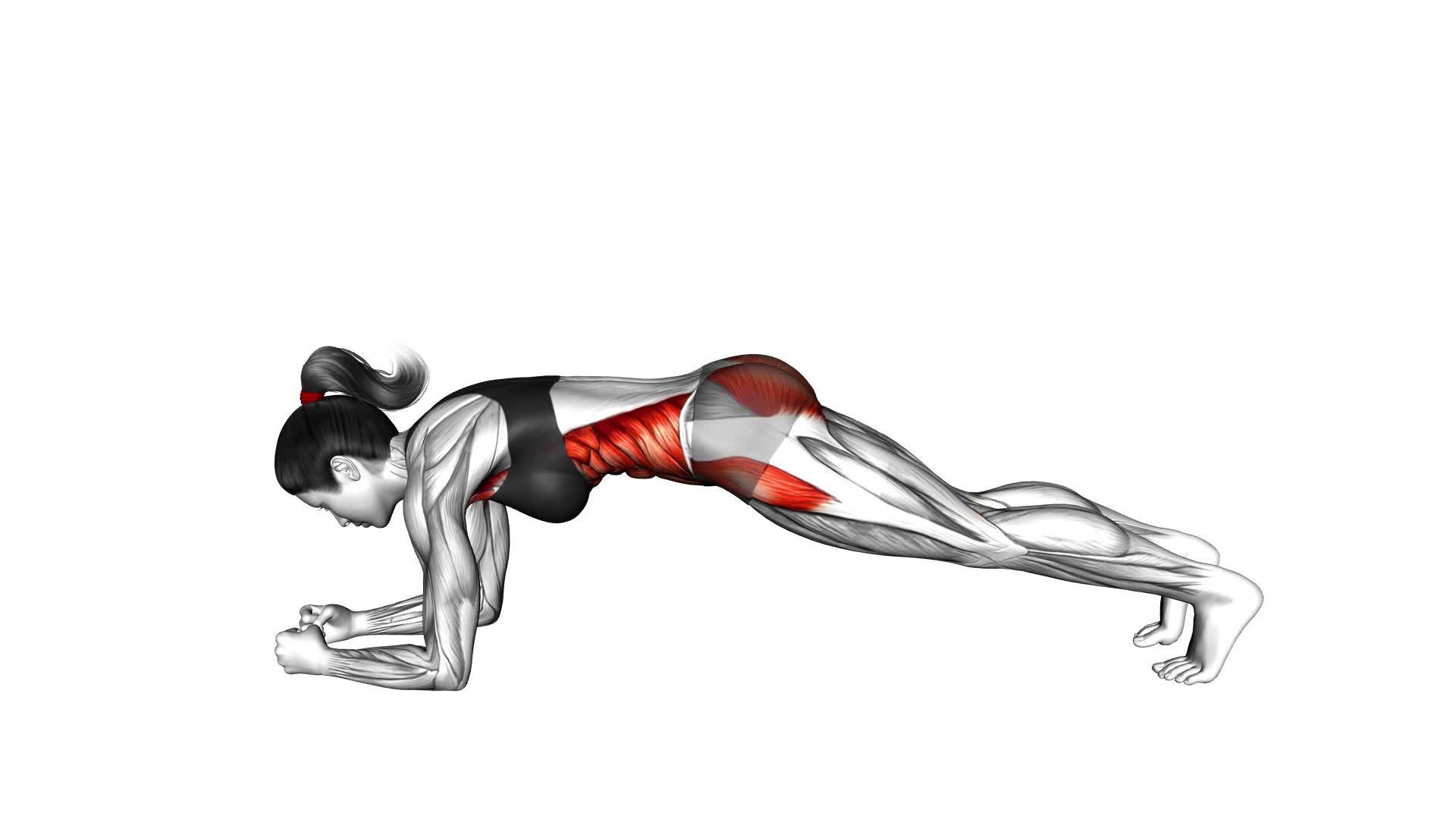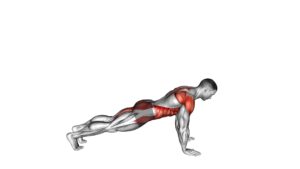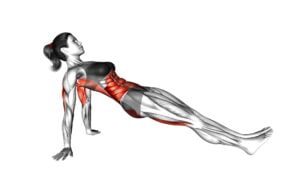RKC Plank (female) – Video Exercise Guide & Tips

Are you looking for a challenging core exercise that targets your abs and back muscles? Look no further than the RKC plank!
Watch This Exercise Video
In this video exercise guide, we'll show you how to perform the RKC plank with proper form and technique. You'll also learn variations and progressions to keep your workouts fresh and effective.
Avoid common mistakes and get the most out of your RKC plank with our helpful tips. Let's get started!
Key Takeaways
- RKC Plank for women increases core strength and stability.
- Proper form and technique include engaging the core, squeezing the glutes, and maintaining a neutral spine.
- Variations and progressions of the RKC Plank target different muscle groups and add resistance.
- Common mistakes to avoid during the RKC Plank include sagging hips, dropping the head, and holding breath.
Benefits of RKC Plank for Women
You'll experience increased core strength and stability with the RKC Plank for women. This exercise specifically targets the muscles in your core, which includes your abs, obliques, and lower back. By engaging these muscles, you'll not only develop a stronger and more defined midsection, but also improve your overall stability and posture.
The RKC Plank requires you to hold a plank position while actively contracting your core muscles. This constant engagement of your core helps to strengthen the deep, stabilizing muscles that support your spine. As a result, you'll notice improved balance and coordination in your daily activities.
In addition to core strength, the RKC Plank offers a range of other benefits for women. It can help to alleviate lower back pain by strengthening the muscles that support the spine. It also improves overall body awareness and control, allowing you to move more efficiently and effectively during workouts and everyday tasks.
The RKC Plank is a versatile exercise that can be modified to suit your fitness level. Whether you're a beginner or an experienced athlete, this exercise will challenge your core and help you reap the benefits of increased core strength and stability.
Incorporate the RKC Plank into your routine and feel the difference it makes in your overall fitness and well-being.
Proper Form and Technique for RKC Plank
To perform the RKC Plank with proper form and technique, start by assuming a plank position on your forearms and toes. Here's how to do it correctly:
- Engage your core: Imagine pulling your belly button towards your spine to activate your deep abdominal muscles. This will help stabilize your body and prevent your lower back from sagging.
- Squeeze your glutes: Contract your glute muscles to create tension in your hips and increase overall stability. This will also help prevent your hips from dropping or rotating during the exercise.
- Maintain a neutral spine: Avoid rounding or arching your back. Keep your spine in a straight line from your head to your heels. Imagine you're balancing a glass of water on your lower back to ensure proper alignment.
It's important to note that the RKC Plank can be modified to suit different fitness levels. Beginners can start by performing the exercise on their knees instead of their toes, gradually progressing to the full plank position. Remember to focus on maintaining proper form and technique throughout the exercise to maximize core activation and get the most out of your RKC Plank workout.
Variations and Progressions for RKC Plank
To progress the RKC Plank and challenge your core even further, you can try incorporating variations that target different muscle groups. These modifications can add intensity and complexity to your plank routine.
One modification is the Elevated RKC Plank, where you place your feet on an elevated surface such as a bench or step. This variation increases the demand on your shoulders, chest, and triceps.
Another advanced variation is the Lateral RKC Plank, which involves shifting your weight onto one arm while extending the other arm towards the ceiling. This variation engages your obliques and improves lateral stability.
Additionally, you can try the RKC Plank with Leg Lifts, where you alternate lifting one leg off the ground. This variation challenges your core and hip flexors.
Lastly, the Weighted RKC Plank involves adding resistance by placing a weight plate or dumbbell on your back. This variation increases the load on your core muscles.
Incorporating these advanced RKC Plank variations into your routine can help you further strengthen and engage different muscle groups, making your core workouts more challenging and effective.
Common Mistakes to Avoid During RKC Plank
Avoid these common mistakes when performing the RKC Plank to ensure proper form and maximize the effectiveness of your workout. Here are three common mistakes to watch out for:
- Sagging Hips: One of the most common mistakes during the RKC Plank is allowing your hips to sag towards the ground. This not only puts strain on your lower back, but it also takes away from the activation of your core muscles. To maintain proper form, engage your core, squeeze your glutes, and keep your hips in line with your shoulders and heels.
- Dropping Your Head: Another mistake to avoid is dropping your head and looking down towards the ground. This can lead to neck strain and poor alignment. Instead, keep your head in a neutral position, aligning it with your spine. This will help maintain a straight line from your head to your heels.
- Holding Your Breath: It's important to remember to breathe throughout the exercise. Holding your breath can cause tension and prevent you from engaging your core properly. Take deep breaths in and out, allowing your breath to flow naturally as you hold the plank position.
By avoiding these common mistakes and maintaining proper form, you'll be able to maximize the benefits of the RKC Plank.
Now, let's move on to some tips for getting the most out of this exercise.
Tips for Getting the Most Out of RKC Plank
To maximize the effectiveness of your RKC Plank, incorporate these three tips into your practice.
First, focus on engaging your core muscles throughout the entire exercise. This means actively squeezing your abs, glutes, and thighs to maintain a stable and strong plank position. By doing so, you'll increase the activation of your core muscles and enhance the benefits of the exercise.
Second, try to hold the plank for as long as you can without sacrificing your form. Start with shorter durations and gradually increase the time as you build strength. This will help to improve your endurance and challenge your core muscles even more.
Lastly, consider modifying the RKC Plank if you're a beginner. Instead of starting with a full plank, you can begin by practicing a modified version on your knees. This will allow you to gradually build up your core strength until you're able to perform the full RKC Plank.
Frequently Asked Questions
What Are the Potential Risks or Injuries Associated With Performing the RKC Plank?
When doing the RKC Plank, it's important to be aware of the potential risks and common injuries. This exercise can put strain on your shoulders, wrists, and lower back if not performed with proper form and technique.
It's crucial to engage your core muscles and maintain a neutral spine throughout the exercise to minimize the risk of injury.
Always listen to your body and stop if you experience any pain or discomfort.
Can the RKC Plank Help With Postpartum Recovery and Strengthening the Core Muscles After Giving Birth?
A great way to focus on postpartum recovery and strengthen your core muscles after giving birth is by incorporating the RKC plank into your exercise routine.
This plank variation can help you regain strength in your abdominal muscles and improve overall core stability.
Is It Necessary to Have Prior Experience With Planks or Other Core Exercises Before Attempting the RKC Plank?
Prior experience with planks or other core exercises isn't necessarily required before attempting the RKC Plank. However, having some familiarity with core exercises can be beneficial as it helps you understand the basic principles of engaging and strengthening your core muscles.
If you're new to core exercises, it's recommended to start with simpler variations of planks and gradually progress to the RKC Plank. Remember to always listen to your body and start at a level that feels comfortable for you.
Are There Any Modifications or Adaptations for Individuals With Lower Back Pain or Injuries?
If you have lower back pain or injuries, there are modifications and adaptations you can make to the RKC plank. It's important to listen to your body and avoid any movements or positions that cause discomfort.
You can try placing a pillow or towel under your lower back for added support. Additionally, you can start with shorter holds and gradually increase the time as your back gets stronger.
How Long Should I Hold the RKC Plank for Maximum Benefit, and How Often Should I Incorporate It Into My Workout Routine?
To get the maximum benefit from the RKC plank, it's important to hold the position for an optimal duration. Aim to hold the plank for about 30 seconds to 1 minute. This will challenge your core muscles and build strength effectively.
As for the frequency, incorporating the RKC plank into your workout routine 2-3 times a week is a good starting point. Remember to listen to your body and gradually increase the duration and frequency as you progress.
Conclusion
In conclusion, the RKC Plank is a highly effective exercise for women that offers numerous benefits.
By focusing on proper form and technique, women can strengthen their core muscles and improve overall stability.
Variations and progressions can be incorporated to challenge and enhance the workout.
It's important to avoid common mistakes and follow the tips provided to maximize the effectiveness of the RKC Plank.
Incorporating this exercise into your routine can lead to improved strength and overall fitness.

Author
Years ago, the spark of my life’s passion ignited in my mind the moment I stepped into the local gym for the first time. The inaugural bead of perspiration, the initial endeavor, the very first surge of endorphins, and a sense of pride that washed over me post-workout marked the beginning of my deep-seated interest in strength sports, fitness, and sports nutrition. This very curiosity blossomed rapidly into a profound fascination, propelling me to earn a Master’s degree in Physical Education from the Academy of Physical Education in Krakow, followed by a Sports Manager diploma from the Jagiellonian University. My journey of growth led me to gain more specialized qualifications, such as being a certified personal trainer with a focus on sports dietetics, a lifeguard, and an instructor for wellness and corrective gymnastics. Theoretical knowledge paired seamlessly with practical experience, reinforcing my belief that the transformation of individuals under my guidance was also a reflection of my personal growth. This belief holds true even today. Each day, I strive to push the boundaries and explore new realms. These realms gently elevate me to greater heights. The unique combination of passion for my field and the continuous quest for growth fuels my drive to break new ground.







